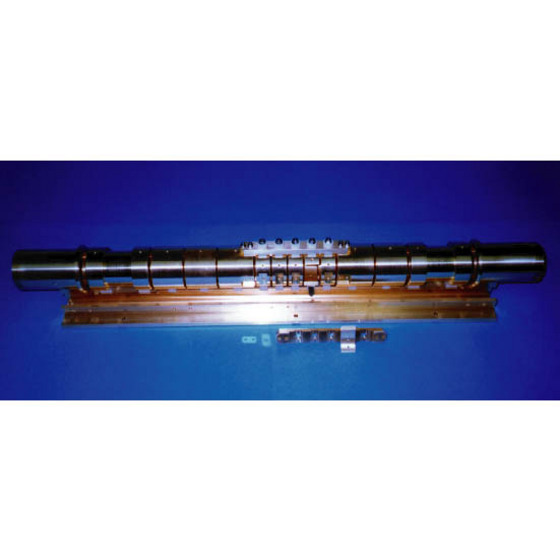Home > Press > Antimatter trap to test nature's symmetry:Origins of our Universe could be probed by detailed study of antihydrogen atoms
 |
| Figure 1: The multi-ring trap, which is used to trap and manipulate a large number of antiproton. |
Abstract:
RIKEN scientists have developed a method for trapping and manipulating antimatter that could be key to solving one of the universe's biggest mysteries.
The technique will allow scientists to "test the most fundamental symmetry of nature," says Yasunori Yamazaki of RIKEN's Advanced Science Institute, Wako.
Antimatter trap to test nature's symmetry:Origins of our Universe could be probed by detailed study of antihydrogen atoms
Japan | Posted on October 31st, 2008"It is believed that our Universe started as the Big Bang some 13 billion years ago," he explains. From that burst of energy coalesced the fundamental particles of matter.
But according to a key part of quantum theory—known as charge, parity and time symmetry (CPT)—the Big Bang should have produced equal amounts of matter and antimatter, which annihilate whenever they meet. So why is our Universe mostly made of matter?
"One possibility … is that CPT symmetry is broken in some way," says Yamazaki. "So we are going to test this CPT symmetry by comparing hydrogen and antihydrogen with high accuracy."
Hydrogen is made from a positive proton and a negative electron, while antihydrogen is made from their antimatter equivalents: a negative antiproton and a positive anti-electron, known as a positron.
One of the most important techniques to advance the CPT symmetry test with antihydrogen is to manipulate an antiproton cloud to efficiently synthesize cold antihydrogen atoms. Yamazaki is leading an international group called MUSASHI, a part of the ASACUSA (Atomic Spectroscopy And Collisions Using Slow Antiprotons) collaboration, which has now developed a way to compress a cloud of antiprotons, an essential precursor to making antihydrogen that can be trapped by a magnetic field1.
First, the team captured and decompressed a cloud of electrons in a trap that uses multi-cylindrical ring electrodes to confine the particles (Fig. 1). The strong magnetic field forces the electrons to emit so-called synchrotron radiation, which cools the electrons. Then about 50,000 energetic antiprotons were injected and mixed with the electrons, which resulted in a sympathetic cooling of the antiprotons by the electrons.
After the cooling process, the electrons were ejected from the trap, and a rotating electric field was applied to compress the antiproton cloud. This reduced the radius of the antiproton cloud to 0.25 mm, an order of magnitude smaller than the original cloud.
It's surprising that antiproton compression can be done with a rotating electric field, says Yamazaki, even after the coolant electrons have been removed. He adds that the team now hopes to synthesize and trap a large enough number of antihydrogen atoms for detailed study, which should help to answer key questions about CPT.
Reference
1. Kuroda, N., Torii, H.A., Shibata, M., Nagata, Y., Barna, D., Hori, M., Horváth, D., Mohri, A., Eades, J., Komaki, K. & Yamazaki, Y. Radial compression of an antiproton cloud for production of intense antiproton beams. Physical Review Letters 100, 203402 (2008).
The corresponding author for this highlight is based at the RIKEN Atomic Physics Laboratory
####
For more information, please click here
Copyright © Riken
If you have a comment, please Contact us.Issuers of news releases, not 7th Wave, Inc. or Nanotechnology Now, are solely responsible for the accuracy of the content.
| Related Links |
| Related News Press |
Physics
![]() Simulating magnetization in a Heisenberg quantum spin chain April 5th, 2024
Simulating magnetization in a Heisenberg quantum spin chain April 5th, 2024
News and information
![]() Simulating magnetization in a Heisenberg quantum spin chain April 5th, 2024
Simulating magnetization in a Heisenberg quantum spin chain April 5th, 2024
![]() NRL charters Navy’s quantum inertial navigation path to reduce drift April 5th, 2024
NRL charters Navy’s quantum inertial navigation path to reduce drift April 5th, 2024
![]() Discovery points path to flash-like memory for storing qubits: Rice find could hasten development of nonvolatile quantum memory April 5th, 2024
Discovery points path to flash-like memory for storing qubits: Rice find could hasten development of nonvolatile quantum memory April 5th, 2024
Discoveries
![]() Chemical reactions can scramble quantum information as well as black holes April 5th, 2024
Chemical reactions can scramble quantum information as well as black holes April 5th, 2024
![]() New micromaterial releases nanoparticles that selectively destroy cancer cells April 5th, 2024
New micromaterial releases nanoparticles that selectively destroy cancer cells April 5th, 2024
![]() Utilizing palladium for addressing contact issues of buried oxide thin film transistors April 5th, 2024
Utilizing palladium for addressing contact issues of buried oxide thin film transistors April 5th, 2024
Announcements
![]() NRL charters Navy’s quantum inertial navigation path to reduce drift April 5th, 2024
NRL charters Navy’s quantum inertial navigation path to reduce drift April 5th, 2024
![]() Discovery points path to flash-like memory for storing qubits: Rice find could hasten development of nonvolatile quantum memory April 5th, 2024
Discovery points path to flash-like memory for storing qubits: Rice find could hasten development of nonvolatile quantum memory April 5th, 2024
|
|
||
|
|
||
| The latest news from around the world, FREE | ||
|
|
||
|
|
||
| Premium Products | ||
|
|
||
|
Only the news you want to read!
Learn More |
||
|
|
||
|
Full-service, expert consulting
Learn More |
||
|
|
||








